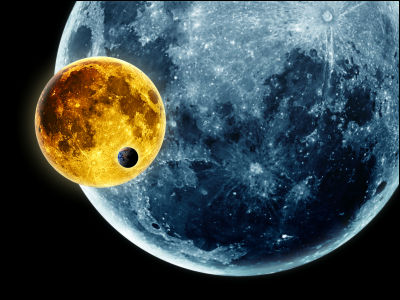What is the security dilemma in 'cislunar space,' which extends from Earth to the lunar orbit?

As space development advances, countries are moving to establish 'space forces' that specialize in space security. Michael Byers , professor of political science at the University of British Columbia , and Aaron Boley, associate professor of astrophysics at the same university, explain the security of ' cislunar space ,' which is considered to be particularly important in outer space, around the Earth's orbit to the moon.
Cis-lunar space and the security dilemma - Bulletin of the Atomic Scientists
https://thebulletin.org/premium/2022-01/cis-lunar-space-and-the-security-dilemma/
Cis-lunar space is a Latin term meaning 'this side of the moon' and refers to the region from Earth's orbit to the Moon's orbit, including the Lagrangian point where a third celestial body can reside stably. At the Lagrangian point, the gravitational and centrifugal forces of the Earth and Moon are balanced, allowing small spacecraft and satellites to orbit the Earth at the same speed as the Moon.
These characteristics make Lagrangian points promising locations for space development where communication and monitoring equipment, supply bases, and space stations can be maintained with relatively low energy. There are five Lagrangian points on the Earth and Moon, but the available volume is limited, making them particularly popular 'space real estate' in cislunar space.
In cislunar space, a fierce space development race is taking place, mainly between the United States and China, but the distance is too far for telescopes and radars on Earth to monitor cislunar space, and it is not possible to monitor the dark side of the moon from Earth. Therefore, in order to monitor activities in space, it is necessary to place monitoring satellites and sensors in cislunar space.
This situation, Byers and his colleagues say, creates conditions for a 'security dilemma,' in which incomplete information about potential enemy activities forces other countries to increase their military presence.

Regarding the Oracle family of systems, Byers and his team acknowledged that 'helping to provide greater awareness of the space situation from cislunar space would undoubtedly be a good thing, as it would provide more information about what other nations are doing, or not doing.' However, they said that monitoring cislunar space is also possible from private spacecraft conducting scientific research, and there are concerns about the military's initiative to launch satellites into cislunar space.
In addition, while there is no problem if the removal of space debris that Oracle-M aims for is carried out peacefully, there is a possibility that such technology could be used to interfere with other countries' spacecraft and satellites. Therefore, Byers and others argue that 'the important and difficult task of removing space debris should be led by each country's space agency.'
The US Defense Advanced Research Projects Agency (DARPA) has also launched the 'Novel Lunar Orbital Manufacturing, Materials, and Mass Efficiency Design (NOM4D)' program, which aims to create large-scale structures in orbit. Although NOM4D explains that it will not build structures on the moon, it is natural that security departments of other countries are wary of this move.
'Even if DARPA does not plan to conduct activities on the moon, it is easy to imagine that other countries will interpret this announcement as a statement of intent to 'militarize the moon,'' Byers and his colleagues wrote. 'As a result, the NOM4D program is likely to create uncertainty about U.S. plans and create security dilemmas for both China and Russia.'

Military activities in cislunar space and on the lunar surface are already prohibited under international law, such as the Treaty on Principles Governing the Activities of States in the Exploration and Use of Outer Space, including the Moon and Other Celestial Bodies (Outer Space Treaty) . Therefore, the U.S. action could not only create a security dilemma, but also violate international law.
Byers and his team argue that cislunar space situational awareness should be shared as a public good to help prevent accidents, and that eventually mechanisms will be needed to monitor the use of Lagrangian points and orbits and to coordinate the agencies that use them. 'We can still develop the Moon and its orbit, but as we've learned from decades of activity in Earth orbit, developing space sustainably requires foresight, planning, and cooperation,' they say.
Related Posts:
in Note, Posted by log1h_ik







